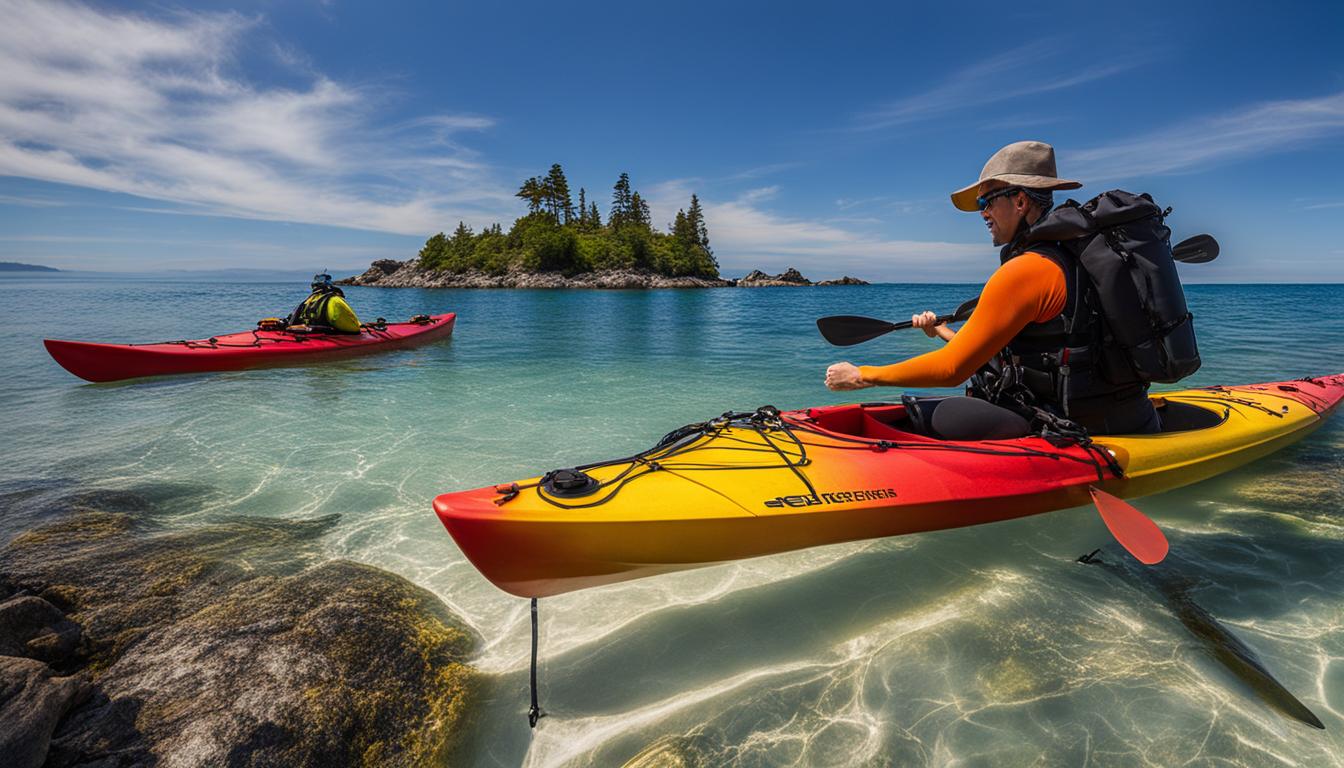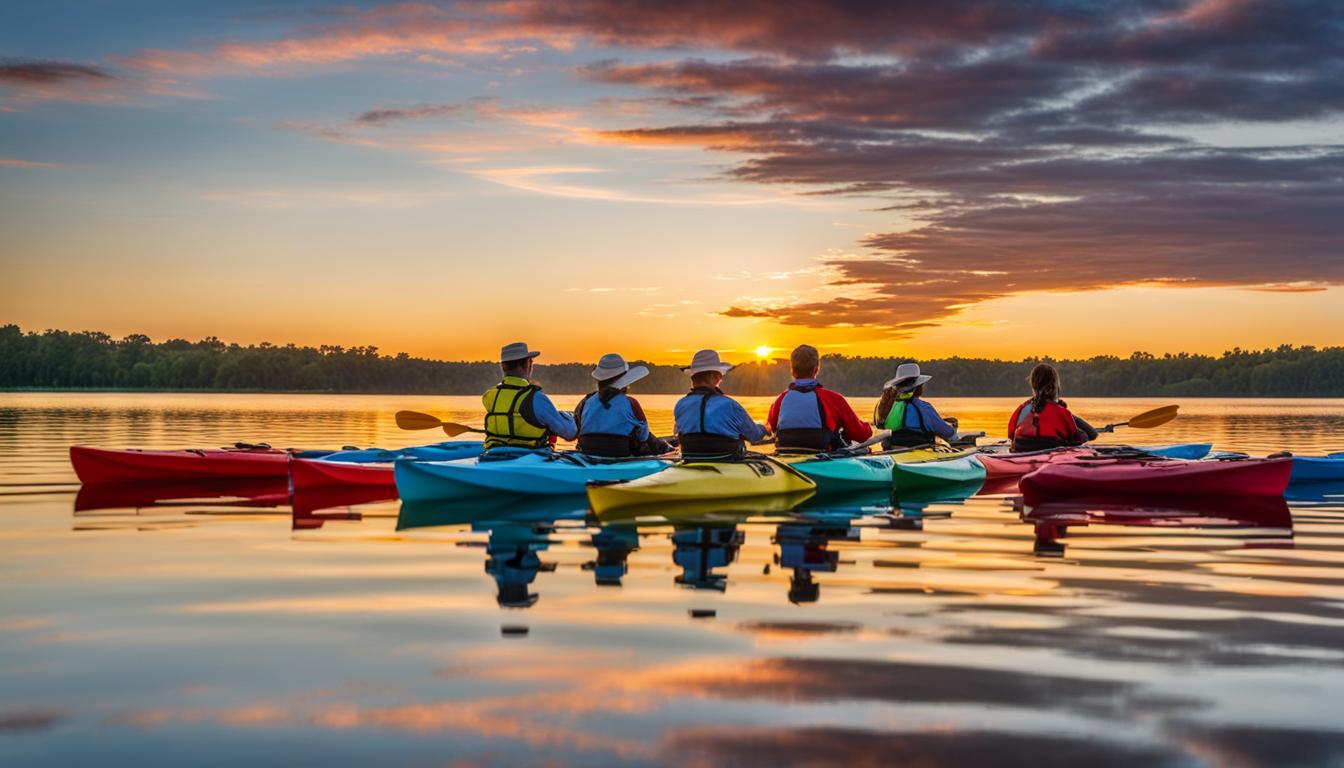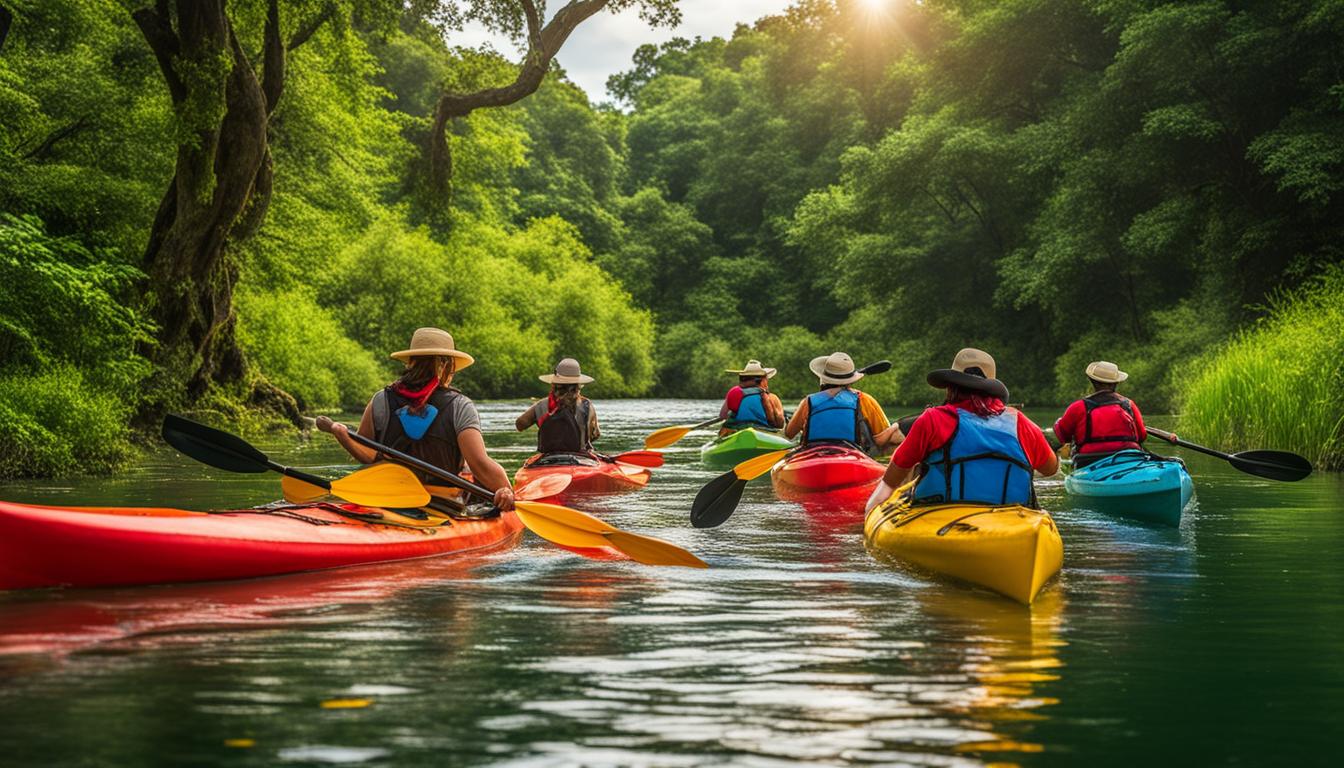When preparing for your next kayaking adventure, it’s crucial to have the right safety equipment on hand. This comprehensive checklist will ensure that you are well-prepared and equipped for a safe and enjoyable time on the water.
The list includes essential items such as personal flotation devices, clothing suitable for the weather conditions, maps and river guides, sunscreen, and a first aid kit. Additionally, it covers advanced safety gear for longer trips or trips with rapids and hazards, including helmets, bilge pumps, compasses or GPS devices, self-rescue devices, spare paddles, and VHF radios. Following this checklist will help you be fully prepared for any kayaking excursion.
Key Takeaways:
- Selecting the right safety gear for kayaking is essential for a safe and enjoyable experience.
- Personal flotation devices (PFDs) are crucial and should be worn by everyone on board.
- Dress appropriately for the weather and water conditions, and protect yourself from the sun.
- For longer or challenging trips, consider advanced safety gear such as helmets, bilge pumps, and VHF radios.
- Always prioritize safety and be prepared for any challenges you may encounter.
Personal Flotation Devices (PFDs)
One of the most important pieces of kayak safety equipment is a personal flotation device (PFD), also known as a life jacket. It is crucial to wear a properly fitting PFD that is approved by the US Coast Guard. PFDs provide buoyancy and can save lives in the event of an unexpected capsize or if you need to assist someone else in the water. It is recommended to have a sound-producing device such as a whistle attached to your PFD. Inflatable life jackets are also an option for those who are at least 16 years old. Always ensure that you and every person on board have a PFD and wear it throughout the kayaking trip.
“Wearing a properly fitted PFD is not only a legal requirement, but it can be the difference between life and death in a water emergency,” says Sarah Johnson, a professional kayaker with over 10 years of experience. “No matter how confident you are in your swimming abilities, accidents can happen, and having a PFD on will give you peace of mind and increased safety.”
When choosing a PFD, look for one that is designed specifically for kayaking. These PFDs typically have a shorter back to accommodate the seating position in a kayak and have multiple adjustment points for a secure fit. Ensure that it is comfortable to wear for extended periods and does not restrict your movement. It is also important to inspect your PFD regularly for any signs of wear or damage and replace it if necessary.
Choosing the Right PFD:
- Ensure it is approved by the US Coast Guard.
- Look for a PFD designed specifically for kayaking with a shorter back and multiple adjustment points.
- Choose a PFD that provides a comfortable fit and does not restrict movement.
- Inspect your PFD regularly for signs of wear or damage and replace if necessary.
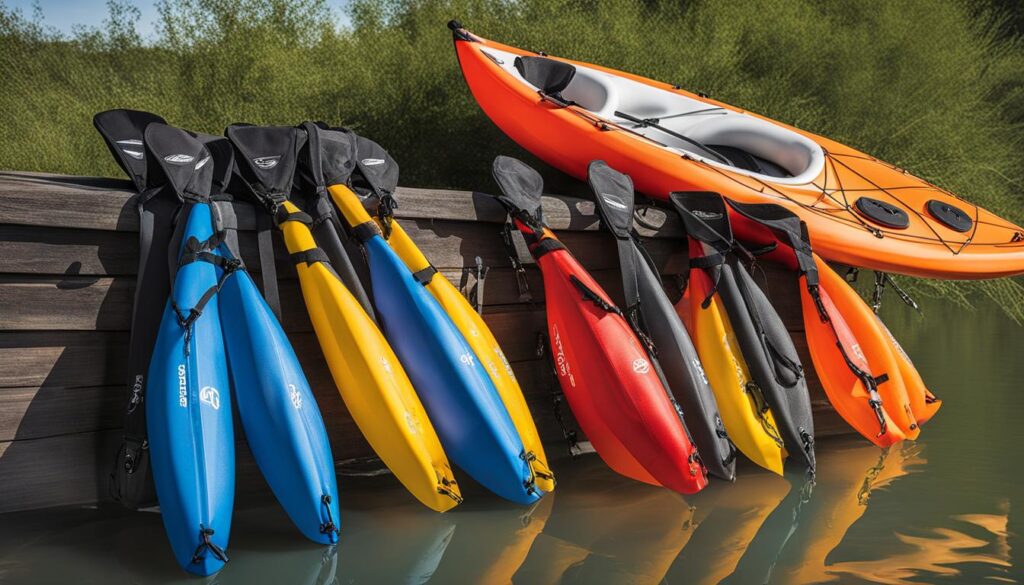
Having the appropriate personal flotation devices is essential for kayak safety. By wearing a properly fitted PFD and ensuring that everyone on board has one, you are taking a crucial step towards a safe and enjoyable kayaking experience.
Essential Clothing and Accessories
When preparing for a kayaking adventure, it’s important to choose appropriate clothing and accessories to ensure your safety and comfort on the water. Dressing appropriately for the weather conditions and protecting yourself from the sun’s harmful rays are key factors to consider.
- Layered Clothing: Opt for clothing that can be easily layered, as temperatures can change rapidly while kayaking. Avoid cotton as it does not insulate well, especially when wet. Choose moisture-wicking materials that can keep you dry and comfortable throughout your trip.
- Proper Footwear: Wear closed-toe sandals or shoes that provide traction and protect your feet from sharp objects in the water or on land. This will ensure stability and prevent injuries.
- Sun Protection: Protect yourself from the sun by wearing sunscreen with a high SPF, UV eye protection such as sunglasses, and a wide-brimmed hat. These will shield you from harmful UV rays and reduce the risk of sunburn and eye damage.
- Extra Clothing: Consider bringing extra clothing in a dry bag, especially if you’re embarking on a longer kayaking trip. This will help keep you warm and dry in case you get wet or encounter unexpected weather changes.
By following these guidelines and choosing the appropriate clothing and accessories, you’ll be well-prepared for a safe and enjoyable kayaking experience. Remember to always prioritize your safety and comfort when venturing out on the water.
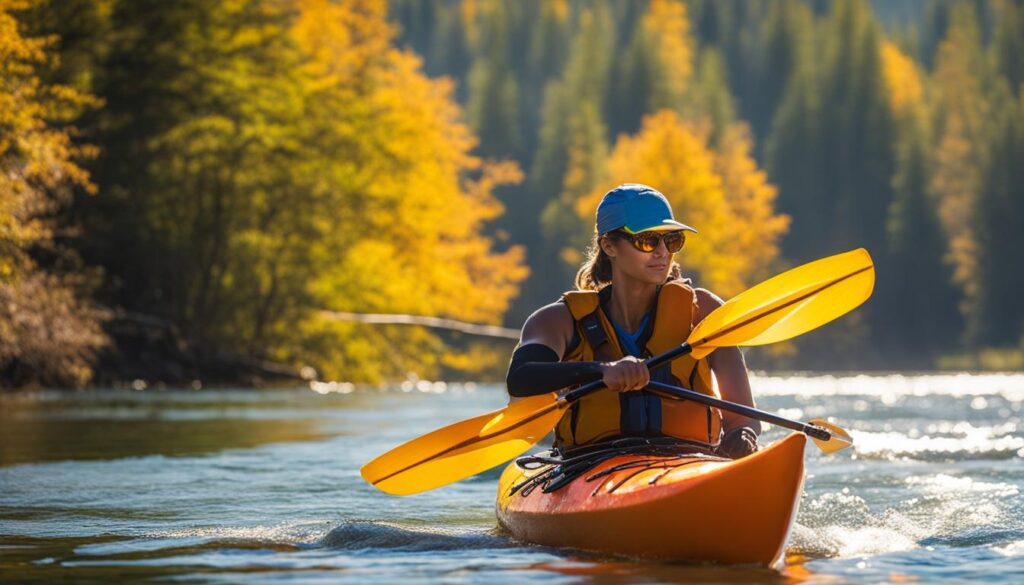
Testimonials
“Wearing the right clothing and protecting myself from the sun made a world of difference during my kayaking trip. I felt comfortable and confident throughout the entire journey.” – Emily
“I never realized how important appropriate footwear is until I experienced a foot injury while kayaking. Now, I always wear closed-toe shoes to ensure my safety on the water.” – Mark
Essential Clothing and Accessories Checklist
| Item | Description |
|---|---|
| Layered Clothing | Choose moisture-wicking materials that can be easily layered for temperature changes. |
| Proper Footwear | Wear closed-toe sandals or shoes for stability and protection. |
| Sun Protection | Apply sunscreen, wear UV eye protection (sunglasses), and a wide-brimmed hat. |
| Extra Clothing | Bring extra clothing in a dry bag for unexpected weather changes or if you get wet. |
Having the right clothing and accessories is crucial for a safe and enjoyable kayaking experience. Use this checklist to ensure you have everything you need before heading out on the water.
Advanced Safety Gear for Longer or Challenging Trips
When embarking on longer kayak trips or venturing into more challenging waters, it is essential to have the right advanced safety gear. These additional items will ensure your preparedness and help mitigate potential risks. Here are some essential items to consider:
Paddle Floats and Self-Rescue Devices
Paddle floats are inflatable devices that attach to a paddle and can be used to aid in self-rescue. They provide additional stability and buoyancy, allowing you to re-enter your kayak more easily in the event of a capsize. Additionally, self-rescue devices such as slings, tow ropes, throw bags, and throw ropes can be invaluable during emergencies or when assisting others in distress. These devices enable you to quickly and safely provide assistance, ensuring the well-being of everyone involved.
Helmet and Safety Accessories
For kayaking in rapids or when using spray skirts or thigh restraints, wearing a helmet is crucial for head protection. A helmet can prevent serious injuries in the event of a collision with rocks or other hard objects. It’s also important to have additional safety accessories such as a whistle or sound signaling device to alert others in case of emergencies. A bilge pump or sponge is essential for removing water from the kayak and keeping it stable, while a compass or GPS device with a reliable map of the river will help you navigate accurately.
Communication and Emergency Equipment
When embarking on longer kayak trips, it’s important to have reliable communication and emergency equipment. Carry a VHF radio to monitor weather conditions and communicate with fellow kayakers or rescue services if needed. Having a spare paddle is also sensible in case your main paddle gets damaged or lost. Additionally, consider carrying water purification tablets or a filter to ensure a safe supply of drinking water during your adventure.
| Advanced Safety Gear | Description |
|---|---|
| Paddle Floats | Inflatable devices that attach to a paddle and aid in self-rescue |
| Self-Rescue Devices | Includes slings, tow ropes, throw bags, and throw ropes for emergencies and assisting others |
| Helmet | Provides head protection during rapids or when using spray skirts or thigh restraints |
| Safety Accessories | Includes whistle or sound signaling device, bilge pump or sponge, compass or GPS device |
| VHF Radio | Enables communication with others and monitoring of weather conditions |
| Spare Paddle | A backup paddle in case the main paddle is lost or damaged |
| Water Purification | Tablets or filter for ensuring a safe supply of drinking water |
By having these advanced safety gear items with you during longer or challenging kayak trips, you’ll be better equipped to handle unexpected situations and ensure the safety of yourself and others. Remember to familiarize yourself with the proper usage of each item and practice using them before embarking on your journey. Stay prepared, stay safe!
Conclusion
Preparing safety gear for kayak trips is an essential step to ensure your safety and enjoyment on the water. By having a comprehensive collection of safety equipment, you can embark on your kayaking adventure with peace of mind.
Comprehensive safety gear for kayaking includes must-have items such as personal flotation devices (PFDs) or life jackets, appropriate clothing and accessories for weather protection, and advanced gear for longer or challenging trips.
Remember, when preparing your safety gear, always prioritize your well-being. Make sure to wear a properly fitting PFD that is approved by the US Coast Guard. Dress appropriately for the weather conditions, protect yourself from the sun, and consider bringing extra clothing in a dry bag. For longer or challenging trips, additional gear such as helmets, sound signaling devices, bilge pumps, compasses, self-rescue devices, spare paddles, and VHF radios are crucial for your safety.
By following this comprehensive checklist and having the essential safety gear, you can confidently explore the waters and make the most of your kayak trips. So, gather your equipment, be prepared, and enjoy your kayaking adventures to the fullest!
FAQ
What is the most important safety equipment for kayaking?
The most important safety equipment for kayaking is a personal flotation device (PFD), also known as a life jacket. It is crucial to wear a properly fitting PFD that is approved by the US Coast Guard. PFDs provide buoyancy and can save lives in the event of an unexpected capsize or if you need to assist someone else in the water.
What should I wear when kayaking?
When kayaking, it is important to dress appropriately for the weather and water conditions. Opt for clothing that can be layered, as temperature changes can occur rapidly. Avoid wearing cotton as it does not insulate well, especially when wet. Wear closed-toe sandals or shoes as proper footwear. Protect yourself from the sun’s harmful rays with sunscreen, UV eye protection (sunglasses), and a wide-brimmed hat. Consider bringing extra clothing in a dry bag to keep yourself warm and dry during the trip.
What advanced safety gear do I need for longer or challenging kayak trips?
For longer kayak trips or trips with rapids and hazards, it is recommended to have additional safety gear. Some essential items include a helmet for whitewater kayaking or when using spray skirts or thigh restraints, a whistle or sound signaling device, a bilge pump or sponge for removing water from the boat, a compass or GPS device with a good map of the river, and a repair kit with duct tape and a waterproof tarp. Self-rescue devices such as paddle floats, slings, tow ropes, throw bags, and throw ropes are also recommended. It is important to have a spare paddle, a VHF radio for emergencies and monitoring the weather, and water purification tablets or a filter.
How can I ensure my safety when kayaking?
To ensure your safety when kayaking, it is important to have the proper kayak safety equipment. This includes wearing a personal flotation device (PFD) at all times, dressing appropriately for the weather and water conditions, and having the necessary advanced safety gear for longer or challenging trips. Following a comprehensive kayak safety equipment checklist will help you be fully prepared for any kayaking excursion.

